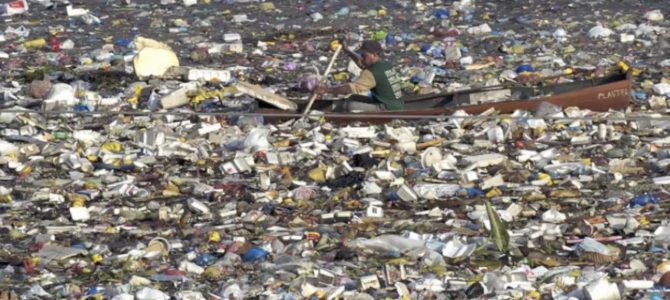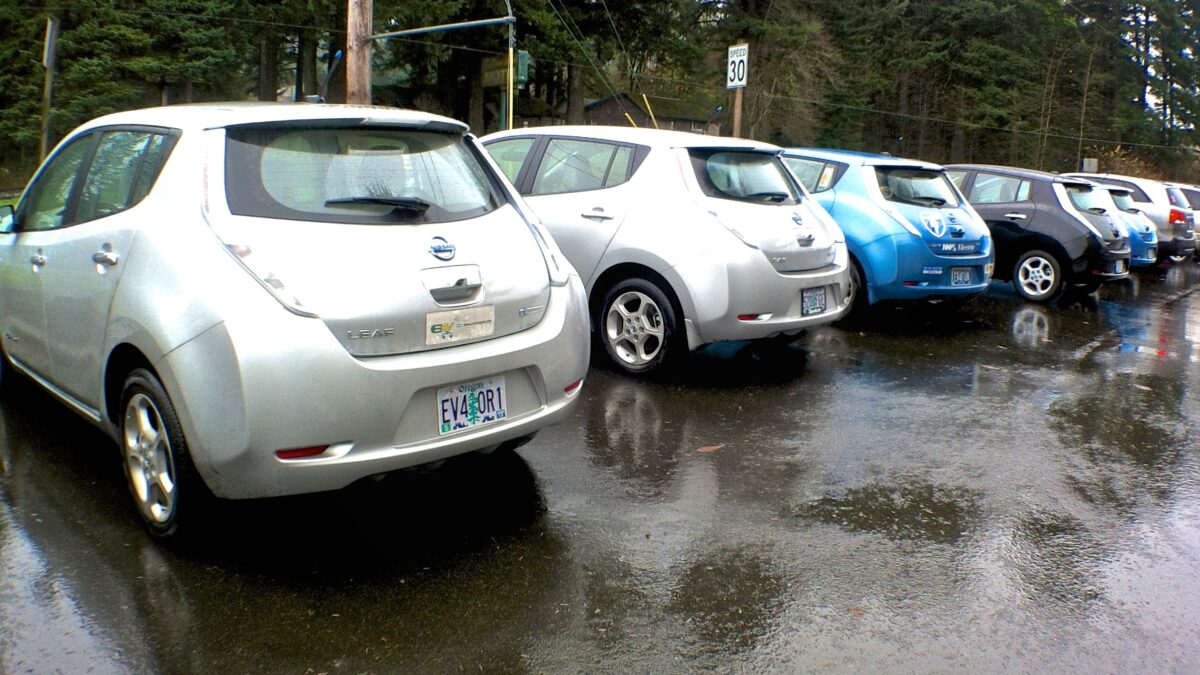
Why should we all be skeptical of doomsday claims about global warming? Well, there are a lot of reasons. But from now on, I can sum it all up in one simple phrase: the Great Pacific Garbage Patch.
This was an environmentalist scare that became a bit of a trend from the late 1990s through the mid-2000s. The idea was that there is a giant floating raft of consumer trash in the middle of the Pacific where ocean currents created a kind of dead spot and all the flotsam and jetsam of the ocean gathered together. It was supposed to be a vast floating indictment—twice the size of Texas! the size of a continent!—of our wicked, wasteful lifestyles.
The problem is that the Great Pacific Garbage Patch never existed.
The picture at the top of this article, shared across the Internet as the iconic image of the garbage patch, is actually from Manila Harbor. The actual supposed location of the “Garbage Patch” would not be nearly as interesting to photograph.
Sure, there are areas of the ocean known as “gyres” that are like stagnant regions within the currents of the oceans where waste and debris and flotsam and jetsam tend to gather. Even if that seems weird or alarming, it’s actually a normal and natural phenomenon, sort of like how those human feet keep washing up in British Columbia because prevailing currents just happen to carry them there.
But scientists have known for a long time that there is nothing like the Great Pacific Garbage Patch reported in the media. There is a small amount of noticeable debris in these areas—old plastic bottles and parts of nets—but the vast majority of the plastic consists of very small flakes, much of it microscopic.
Nor is there anything obviously scary about it. Take this piece from 2012, which admits to the exaggerations but still tries to assure us that we should be very concerned. Yet if you read through it looking for specific negative consequences, you pretty much get something about how these regions have more water strider larvae being laid on all those little bits of plastic. Which is really bad because—well, there’s no specific reason it’s bad, just a general invocation of the idea that “the ecosystem is out of balance.” It’s all pretty vague.
Over at RealClearScience, Tom Hartsfield summed it up last year.
So, here are the facts. Much of the ocean contains little to no plastic at all. In the smaller ocean gyres, there is roughly one bottle cap of plastic per 50 Olympic swimming pools’ worth of water. In the worst spot on earth, there is about two plastic caps’ worth of plastic per swimming pool of ocean. The majority of the plastic is ground into tiny grains or small thin films, interspersed with occasional fishing debris such as monofilament line or netting. Nothing remotely like a large island exists. Clearly, the scale and magnitude of this problem is vastly exaggerated by environmental groups and media reports.
The problem isn’t just that environmentalists were wrong about yet another scare story—though that sure seems to happen a lot. The problem is that that they just don’t care about being wrong. They think it’s okay to make up stories like this and to lie to us in order to stampede us into following their agenda.
How do I know this? Because it is stated pretty much openly in a new article by Slate columnist Daniel Engber. The best part is actually the opening, where Engber gives us the origin of the myth:
In early August 1997, Charles Moore found himself floating through the North Pacific in his Tasmanian-built catamaran. Moore, an oil heir, activist, and yachting captain, had just finished up a two-week race and was heading back from Honolulu to Santa Barbara, California, through what’s called a “gyre”—an area of the ocean like the Sargasso Sea, wrapped inside a giant weather spiral, that serves as a reservoir for flotsam. As he described it in a 2003 article for Natural History, the thousand-mile journey took him through an endless field of plastic—3 million tons of it in all, he guessed, in an area about the size of Texas. Everywhere he looked he saw debris: bottles, bottle caps, wrappers, fragments. And when he returned to this “Garbage Patch” a year later, he found a vast “plastic-plankton soup” and a litany of bigger objects: a volleyball, a cathode-ray tube for a 19-inch TV, a truck tire mounted on a steel rim, and a gallon bleach bottle so brittle that it crumbled in his hands. Moore’s Garbage Patch would grow in size and fame in the years that followed.
So it all begins with an oil heir on his way back from a yacht race—the ultimate example of the “limousine liberal.” There’s no better way to atone for dad’s money, without having to actually give it up, than to discover a new rallying cry for the environmentalist cause.
Engber makes clear that is just a rallying cry—and declares that this is acceptable because the cause is so very necessary that accuracy is not really important.
It was this false appraisal—this projection of collective guilt as a trash archipelago—that brought the problem of marine debris back into the public eye. It gave us all a way to comprehend, or at least hallucinate, what was otherwise a widespread, microscopic devastation.
Comprehension versus hallucination—hey, what’s the difference? Who knew Shruggie was a symbol of science? ¯\_(ツ)_/¯
If you think I’m being unfair to Engber, he makes his point clearer in an analogy to the “ozone hole.”
The same metaphor worked beautifully in the fight against depletion of the ozone layer…. A 1984 report from the National Academies of Science found no trend of decreasing ozone, and the media declared the crisis over. The “great ozone scare” was even cited during early congressional hearings on global warming, as an example of alarmism. Then in 1985, a team of British scientists in Antarctica published observations of a “hole” in the ozone layer. It wasn’t quite a hole, but a relative decrement in the quantity of local ozone near the South Pole during a particular time of year. Still, the global problem of chlorofluorocarbon emissions, leading to the degradation of the atmosphere, had been focused on a single spot.
So it’s okay to lie and exaggerate about the garbage patch, and it’s okay to oversimplify and exaggerate about the ozone hole. Because, hey, people are stupid and you have to come up with an image that will play on their imagination in the press. Naturally, it follows that we need to come up with a similar way to lie and exaggerate about global warming: “it could only help to have a better metaphor for climate change—something more evocative than the threat of shrinking ice caps, and longer-lasting than a violent storm.”
This is a classic case of “noble cause corruption.” This is what happens when you are so convinced that you’re the good guy who’s fighting for the good cause—or at least when you would really like for this to be true—that if you have to lie, that’s justified because it’s for the greater good.
The term was first coined to describe the police officer who breaks basic rules—planting evidence or extracting forced confessions—because he just knows that a suspect is guilty and wants to make sure the scumbag gets convicted. But the basic contradiction is pretty obvious: if you had to plant the evidence, then how did you “just know” the guy was guilty? Similarly, if you have to lie to the public about the urgent problem of plastic waste, or the ozone layer, or global warmin, then how do you know you’re not also lying to yourself about how big the problem is and how certain you are about it?
This is the original sin of the global warming crusade: that it took the assumption that man is destroying the earth as an unquestioned starting point, then found it acceptable to fudge the details to support this “larger truth.”
A cop caught planting evidence is considered tainted forever and might see all of his convictions thrown out by the courts. The same thing goes for a scientist, much less for a bunch of liberal arts majors on the Internet who play at telling us how much they freaking love science—just not enough to be exact about the truth.
That’s why, if I have to sum up why I’m skeptical about global warming and have no desire to totally reshape our society to deal with this phantom threat, I will simply cite the Great Pacific Garbage Patch that never was.
When environmentalists tell you openly that they’re lying to you and they think that’s okay, then you would be a fool not to be a skeptic.
Follow Robert on Twitter.









